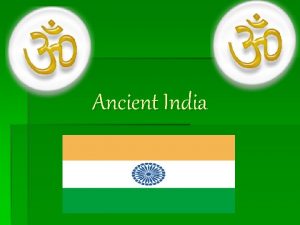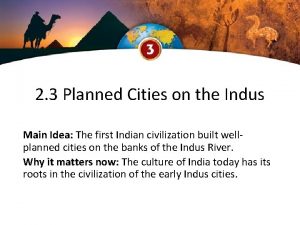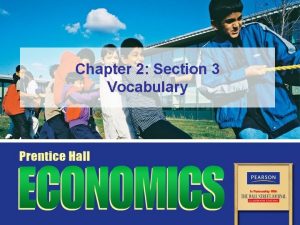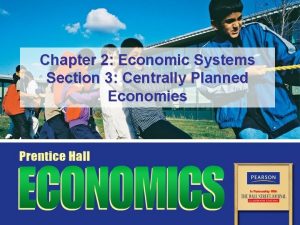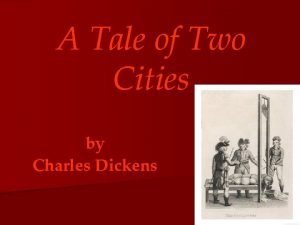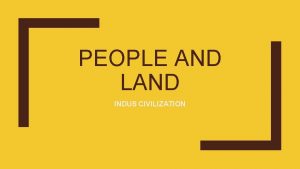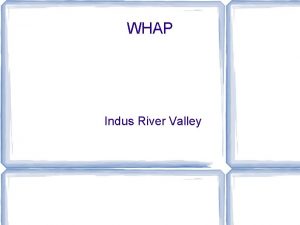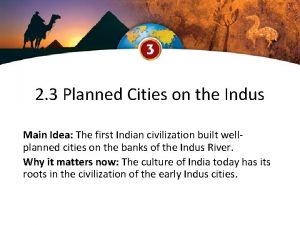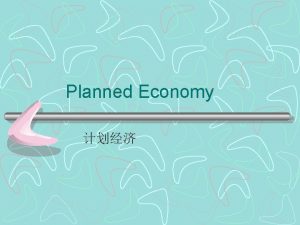Planned Cities on the Indus Chapter 2 Section








- Slides: 8

+ Planned Cities on the Indus Chapter 2: Section 3

+ n Geography Geographers often refer to the landmass that includes India, Pakistan, and Bangladesh as the Indian subcontinent n There are mountains to the north n Desert to the east n Both of these items guarded this area from foreign invaders n The Indus and the Ganges are the two rivers that make this area such a fertile land n Like the Tigris, the Euphrates, and the Nile, these rivers carry not only water for irrigation, but also silt which produces rich land for agriculture n Below the Indo-Gangetic Plain, southern part of the subcontinent is a peninsula

+ n Geography Continued Monsoons n Seasonal winds called monsoons dominate India’s climate n From October-February, winter monsoons from the NE blow dry air westward across the county n Then they shift in June n When the summer monsoons fail-drought occurs causes crop disasters but if too much than it floods and could wipe out entire villages n Environmental Challenges n Similar to that of Mesopotamia and Egypt n Yearly floods spread deposits of rich soil n Unpredictable flooding n Cycle of wet and dry seasons brought those monsoon winds

+ n Civilization Emerge in the Indus Historians know less about the Indus than any of the other River Valleys n The main reason is we have not deciphered their writing system n What we do know comes from archaeological digs, however, the floods took away many artifacts n No one is sure how human settlement began in the Indus n Some think they came from the sea via Africa n Some think Northern immigrants made their way through the Hindu Kush mountains

+ Planned Cities n Around 2500 B. C. while Egyptians were building the pyramids the people of Indus were setting up shop n They had strong levees and walls to keep water out n When that didn’t work they made islands to raise the cities above possible flood waters n The largest cities were Mohenjo-Daro and Harappa. n The Indus is sometimes referred to as Harappan Civilization n One of the most remarkable achievements of the Indus River Valley was their planning n n n Mesopotamia was a hot mess of buildings connected by a maze of winding streets whereas Indus laid out their cities on a grid system In the center was the Citadel which was the major buildings of the city Engineers of the time also created a plumbing and sewage system n These systems were better than anything built before the 19 th century in other civilizations

+ Harappan Culture n Language n Impossible to decipher n Unlike the other civilizations we have not found and inscriptions that are bilingual n Culture n Uniform in Religion and Culture n Artifacts such as clay and wooden children’s toys suggest a relatively prosperous society that could afford to make nonessentials n Presence of animal images on many artifacts suggest that animals were important part of the culture n Some of these show animals of the area and some show beast with several different animal parts

+ Religion and Trade n n Ruler of the Harappan civilization believed in close ties to religion n We think they were a theocracy however no site of a temple has been found n Figures show what may have been the Hindu figure Shiva Thrived on trade with peoples in the region n Gold and Silver came from the north in Afghanistan n Excellent means of transportation for trade goods n Provided a link to the sea

+ Indus Valley Culture Ends n 1750 quality of building the cities of the Indus Valley declined n Cities fell to decay and really what happened remains a mystery n You can tell that there were shifts in tectonic plates and that could have caused earthquakes and floods and altered the course of the Indus River n Some cities suffered, some survived, and some were destroyed n Another theory is that they suffered soil that was exhausted by overuse n Final theory is that Nomadic people swept into the Valley
 Planned cities on the indus worksheet answers
Planned cities on the indus worksheet answers Planned cities on the indus
Planned cities on the indus A wise economist asks a question
A wise economist asks a question Chapter 2 section 3 centrally planned economies
Chapter 2 section 3 centrally planned economies Describe how a centrally planned economy is organized
Describe how a centrally planned economy is organized A tale of two cities book 2 chapter 3 summary
A tale of two cities book 2 chapter 3 summary Chapter 10 section 1 meiosis
Chapter 10 section 1 meiosis Hát kết hợp bộ gõ cơ thể
Hát kết hợp bộ gõ cơ thể Lp html
Lp html
